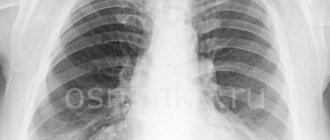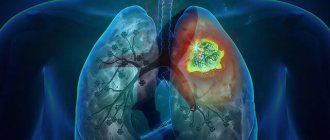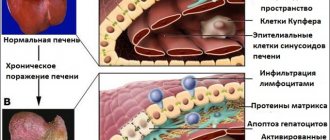Lobar pneumonia is an acute infectious disease in which one or more lobes of the lung are affected, fibrinous effusion appears in the alveoli, and fibrinous deposits appear on the pleura. Croupous pneumonia affects mainly adults. The disease is characterized by a pronounced clinical picture and symptoms of intoxication. Patients with lobar pneumonia are admitted to the therapy clinic.
To examine patients at the Yusupov Hospital, doctors use modern equipment from leading European, American and Japanese companies. Pulmonologists use European treatment protocols and take an individual approach to the choice of treatment method for each patient. Medicines are administered through the digestive tract, intramuscularly, intravenously and by inhalation. Thanks to complex treatment, the length of stay of patients in hospital is reduced.
Signs of lobar pneumonia in adults
With lobar pneumonia, symptoms appear acutely. Key ones:
- a sharp increase in temperature to 39 - 40 ° C;
- severe chills, weakness;
- chest pain when breathing;
- cough - at first dry, but quickly becomes wet, with rust-colored sputum;
- severe shortness of breath;
- wheezing that may be heard when breathing;
- rapid heartbeat, low blood pressure;
- pale skin, nausea, muscle weakness.
The general condition is serious, the patient needs the help of doctors in the hospital.
Symptoms of lobar pneumonia
Lobar pneumonia has an acute onset. In patients in full health, body temperature rises to 39 ° C, chills and chest pain appear. In the initial stage of the disease, the cough is dry, then it becomes productive, with the release of “rusty” sputum. There is severe shortness of breath, the chest on the affected side lags behind when breathing.
In the initial phase of inflammation, percussion reveals a dull tympanic sound over the lesion. During auscultation, harsh breathing with prolonged exhalation, mild crepitus, and wet and dry rales in a limited area are heard. In the compaction phase of lobar pneumonia, the following symptoms appear:
- a sharp increase in vocal tremors, bronchophony during palpation of the chest;
- with percussion – dull sound;
- vesicular breathing is not audible, crepitus disappears, and pleural friction noise is often heard.
In the resolution phase, vocal tremors gradually normalize, bronchophony disappears, and abundant, sonorous crepitus appears over a long period of time. Loud fine-bubble rales are heard, bronchial breathing gradually gives way to harsh and then vesicular breathing.
When examining the cardiovascular system, a rapid pulse is determined. In the case of severe lobar pneumonia, it is poorly filled, arrhythmic, blood pressure is reduced, and the heart sounds are muffled.
Stages of lobar pneumonia in adults
Lobar pneumonia proceeds according to a special scenario, with a change of stages with typical changes in the lung tissue.
Stage one - high tide. A lot of blood flows to the lung tissue, which is why it turns red, and blood stagnates in small vessels. The stage lasts from 12 - 14 hours to 3 days.
Stage two – red liver. During this period, some of the fluid and red blood cells leak out of the small vessels of the lungs into the alveoli, which is why they work poorly. The affected part of the lung becomes dense, similar in appearance to liver tissue. Fibrin accumulates inside the lung sacs, a sticky substance that gives the tissue its density. This stage lasts up to 3 days.
Stage three – gray hepatization. Red blood cells stop entering the lung tissue, they are replaced by leukocytes and fibrin, epithelium. Therefore, the color of the lungs changes to gray and greenish. The stage lasts from 2 to 6 days.
Stage four – resolution. Gradually, fibrin dissolves, the alveoli are cleared, the lungs are restored and begin to breathe normally. This process is the longest, can last up to 2 - 3 weeks.
Features of the course of the disease in children
Children rarely experience fever and chills, and they do not complain of pain in the side.
An atypical course of lobar pneumonia is observed in young children. At the onset of the disease, there is no cough, but other symptoms occur: dry mouth, bloating, nausea and vomiting, abdominal pain, pale skin, rapid breathing, hyperexcitation or lethargy, enlarged liver. Sometimes there is a stiff neck, headache, convulsions, delirium and hallucinations. The combination of such symptoms can cause an incorrect diagnosis (meningitis). As pneumonia progresses, meningeal signs give way to the classic clinical picture of pneumonia.
Croupous pneumonia rarely develops in children. People aged 18-40 years are most susceptible to it.
In children 7-16 years old, symptoms do not differ from those that occur in adults. Body temperature stabilizes on days 5-9 from the onset of the disease. At the same time, inflammation in the lungs subsides.
Modern methods of treatment
To treat lobar pneumonia, your doctor will prescribe two antibiotics.
One drug is administered intravenously, the second intramuscularly. Usually these are drugs from the group of penicillins and cephalosporins. Stronger medications are required less often. Additionally, complex therapy is required:
- immunocorrection (blood plasma and immunoglobulins are administered);
- correction of blood clotting disorders (intravenous blood thinning solutions, heparin);
- normalization of the protein composition of the blood (intravenous albumin, retabolil);
- oxygen (supplied through a nasal catheter or mask);
- hormonal drugs (for severe cases, prednisone is used for a short course);
- antioxidant therapy (ascorbic acid, rutin);
- bronchodilators (Berodual, Eufillin, Atrovent);
- expectorants (ACC, Bromhexine, Ambrobene, Lazolvan);
- antipyretic drugs (Nurofen, Paracetamol, Ibuklin);
- physiotherapy, massage, exercise therapy.
As the patient’s condition improves, he undergoes a course of rehabilitation to completely eliminate foci of inflammation in the lungs.
Modern classification of community-acquired pneumonia:
- By pathogenesis:
a. Primary - pneumonia that developed as an independent disease
b. Secondary - pneumonia that develops against the background of another disease, such as influenza
- By localization:
a. Unilateral (left-sided and right-sided pneumonia)
b. Double-sided
- Based on the volume of tissues involved in inflammation, the following types of pulmonary pneumonia in adults and children are distinguished:
a. Focal - a small focus of inflammation (bronchopneumonia - with damage to the bronchi and respiratory sections)
b. Segmental - involving one or more segments of the lung
c. Lobar - with damage to the lobe of the lung (lobar pneumonia - with damage to the alveoli and part of the pleura)
d. Confluent - when lesions merge into larger ones
e. Total - damage to the entire lung
- Depending on the etiology and characteristics of the patient:
a.
Typical (in patients without severe immune disorders):- Bacterial
Viral pneumonia
- Fungal
- Mycobacterial
- Parasitic
b. In patients with severe immunocompromise :
- In patients with acquired immunodeficiency syndrome
- In patients with other diseases and pathological conditions
c. Aspiration pneumonia/lung abscess/pneumonia (one lung)
Popular questions and answers
Pulmonologist Marina Samoilova told us why lobar pneumonia is so dangerous and how to treat it.
What complications can occur with lobar pneumonia?
If a person has a weakened immune system or treatment is started untimely or incorrectly, complications are possible in the form of:
- abscess (purulent melting of lung tissue); gangrene of the lung;
- purulent pericarditis (inflammation of the lining of the heart);
- purulent brain damage;
- blood poisoning;
- respiratory failure and even death.
Pneumococcal pneumonia, even in our time, is a fairly common cause of death, especially in older people, smokers, people suffering from alcoholism, with cancer and systemic diseases, and HIV-infected people.
Prognosis and prevention
The best treatment for pneumonia is prevention. Vaccines are available for children from two months of age. It is important to take care of the diet of a patient with pneumonia. During treatment, rest, bed rest and plenty of fluids are recommended to prevent dehydration of the baby's body after the formation of a large amount of mucus and due to increased sweating.
Typically, at the onset of the disease, children experience loss of appetite, but as they recover, it returns to normal. A healthy and nutritious diet is recommended to avoid nutritional deficiencies that can lead to other disorders in the body.
It is necessary to control the environment in which the patient is located, whether in a medical facility or at home. Avoid the presence of smoke (such as tobacco) or other lung irritants that may aggravate the condition.
After discharge from the hospital, children require clinical observation and rehabilitation measures. It is also recommended to strictly follow the doctor’s recommendations after recovery, correct daily routine, and moderate intake of vitamins as a preventive measure. Dosed physical activity contributes to the overall recovery of children and can prevent recurrence of pneumonia.
Is it possible to treat lobar pneumonia with folk remedies?
As a rule, patients with lobar pneumonia should be hospitalized for constant monitoring by medical staff and emergency measures at the slightest sign of complications.
Often such patients experience nausea, vomiting, bowel movements, and confusion, so medications and solutions are administered intravenously. Thus, we cannot talk about treatment at home without the participation of qualified specialists. Fortunately, in our time, subject to a healthy lifestyle, such serious diseases as lobar pneumonia are becoming less and less common, and with modern treatment methods, in most cases it is possible to avoid serious complications and save the patient’s life.
Published on the portal kp.ru
Features of community-acquired pneumonia
Determining the pathogen is often a difficult task due to the difficulties in obtaining a substrate for diagnostics and often the lack of sufficient time for additional diagnostics. In addition, patients often develop a mixed infection.
The most common causative agent of bacterial infection (30–50% of cases) is the pneumococcus Streptococcus pneumoniae. The so-called atypical strains, undetectable by bacterioscopy and culture on conventional nutrient media, account for up to 30% of cases of the disease (Chlamydophila pneumoniae, Mycoplasma pneumoniae, Legionella pneumophila). 3–5% of cases of bacterial pneumonia are associated with rare pathogens (Haemophilus influenzae, Staphylococcus aureus, Klebsiella pneumoniae, other enterobacteria). Extremely rarely, community-acquired pneumonia can be caused by Pseudomonas aeruginosa (in the presence of bronchiectasis or in patients with cystic fibrosis).
Viral forms of CAP are caused by respiratory viruses: influenza virus, coronaviruses, rhinosyncytial virus, human metapneumovirus, human bocavirus. In most cases, respiratory viruses cause mild pneumonia with a self-limiting nature, however, in elderly and senile people, in the presence of concomitant bronchopulmonary, cardiovascular diseases or secondary immunodeficiency, the development of severe, life-threatening complications is possible.
Secondary bacterial pneumonia can be a complication of a primary viral infection of the lungs or an independent late complication of influenza.
Sputum due to pneumonia is dark in color
The appearance of rust-colored sputum can be observed in smokers. This suggests that you need to get rid of the bad habit urgently. Also, dark color of sputum can be observed when consuming certain foods and drinks, for example, chocolate, coffee, red wine.
If dark-colored sputum is present for a long time, this may be a sign of:
- chronic pneumonia;
- chronic bronchitis;
- tuberculosis;
- lung cancer;
- pneumoconiosis.
In any case, the patient should consult a doctor.
Sputum due to pneumonia is yellow in color
The appearance of a yellow tint in the sputum may indicate the development of acute pneumonia and acute bronchitis. It can also be a sign of allergies and asthma.
Yellow sputum indicates the body is fighting the virus and the immune system is functioning normally. Thick, dark yellow mucus may be due to a bacterial infection in sinusitis. If such a symptom appears, you should immediately seek medical help.
Trust your health to professionals. Doctors at the Yusupov Hospital are leading specialists in Russia who, based on the test results, will make an accurate diagnosis and develop an effective treatment plan for each patient.
Pneumonia is often a consequence of improperly prescribed treatment. In public clinics, quite often patients are treated for pathologies that they have never had, while the underlying disease develops at a faster rate. This picture is observed due to the low qualifications of doctors in state clinics, poor equipment of hospitals with modern medical equipment and the lack of medicines.
White or gray sputum
Transparent sputum, discharge of white and gray shades are absolutely normal. But their excessive quantity may indicate various pathologies, namely:
- allergies;
- chronic bronchitis;
- respiratory tract infections;
- pulmonary edema.
Gray sputum may be the result of smoking or severe air pollution.
Diagnostics at the Yusupov Hospital will either refute the suspicion of pathology, and the patient will know for sure that nothing threatens his health, or will allow a timely course of effective treatment to be prescribed and prevent the development of severe complications.
To make an appointment with a doctor at the Yusupov Hospital, you do not need to stand in queues, adjust your work schedule, the hospital administrators will coordinate a visit to the doctor at a time convenient for each patient.








